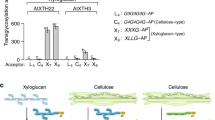Abstract.
Cellulose microfibrils containing crystalline β-1,4-glucan provide the major structural framework in higher-plant cell walls. Genetic analyses of Arabidopsis thaliana now link specific genes to plant cellulose production just as was achieved some years earlier with bacteria. Cellulose-deficient mutants have defects in several members of one family within a complex glycosyltransferase superfamily and in one member of a small family of membrane-bound endo-1,4-β-glucanases. The mutants also accumulate a readily extractable β-1,4-glucan that has short chains which, in at least one case, are lipid linked. Cellulose could be made by direct extension of the glucan chain by the glycosyltransferase or, as the mutant suggests, by an indirect route which makes lipid-linked oligosaccharides. Models discussed incorporate the known enzymes and lipo-glucan and raise the possibility that different CesA glycosyltransferases may catalyse different steps.
Similar content being viewed by others
Author information
Authors and Affiliations
Additional information
Received 5 January 2001; received after revision 25 April 2001; accepted 25 April 2001
Rights and permissions
About this article
Cite this article
Williamson, R., Burn, J. & Hocart, C. Cellulose synthesis: mutational analysis and genomic perspectives using Arabidopsis thaliana. CMLS, Cell. Mol. Life Sci. 58, 1475–1490 (2001). https://doi.org/10.1007/PL00000790
Issue Date:
DOI: https://doi.org/10.1007/PL00000790




